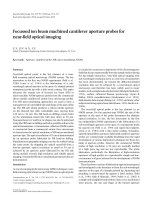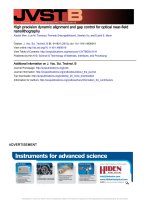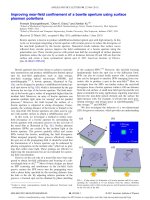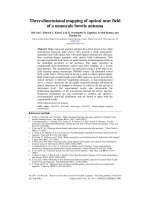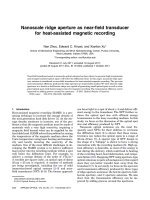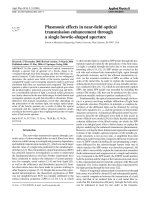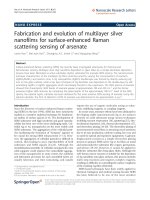Near field coherent anti stokes raman scattering (CARS) microscopy for bioimaging
Bạn đang xem bản rút gọn của tài liệu. Xem và tải ngay bản đầy đủ của tài liệu tại đây (5.46 MB, 135 trang )
Near-field Coherent Anti-Stokes Raman Scattering (CARS)
Microscopy for Bioimaging
LIN JIAN
NATIONAL UNIVERSITY OF SINGAPORE
2012
NEAR-FIELD COHERENT ANTI-STOKES RAMAN
SCATTERING (CARS) MICROSCOPY FOR BIOIMAGING
LIN JIAN
A THESIS SUBMITTED
FOR THE DEGREE OF DOCTOR OF PHILOSOPHY
DEPARTMENT OF BIOENGINEERING
NATIONAL UNIVERSITY OF SINGAPORE
2012
DECLARATION
I hereby declare that the thesis is my original work and it has been
written by me in its entirety. I have duly
acknowledged all the sources of information which have
been used in the thesis.
This thesis has also not been submitted for any degree in any
university previously.
LIN JIAN
16 August 2012
I
Acknowledgements
First and foremost, I want to thank my advisor Assistant Professor Huang Zhiwei,
who provided me the opportunity to pursue the PhD degree in his group. I appreciate
his professional and patient guidance, from the study of basic theory and the design of
experiments to the development of new ideas, as well as the financial support
throughout my four-year study.
I want to acknowledge Dr. Wang Haifeng in Data Storage Institute of Singapore
(DSI), who taught me the finite-difference time-domain method for simulating
electromagnetic waves. I would like to thank Professor Colin Sheppard and Associate
Professor Chen Nanguang, who gave me much valuable advice on my research work. I
am grateful to Professor Hanry Yu and his group members, who taught me much
knowledge on biology and the experimental skills in animal studies and sample
preparations.
I also appreciate the friendship and great support of my coworkers and group
members. Special thanks go to Dr. Lu Fake for his selfless help to my experiments and
constructive discussions. I would like to extend my thanks to other coworkers and
group members in Optical Bioimaging Laboratory: Dr. Zheng Wei, Dr. Yuen Clement,
Mo Jianhua, Teh Seng Knoon, Shao Xiaozhuo, Lin Kan and Shiyamala Duraipandian
for their kind discussions, suggestions and guidance on my research work, and Dr. Lim
Chin Seong in DSI for his kind help to coat gold on the aperture-less probes.
Finally, I wish to thank my dear parents for their unconditional love and my wife,
Dr. Xia Yijie, for her endless support and loving care.
II
Table of Contents
Acknowledgements I
Table of Contents II
Abstract IV
List of Figures VI
List of Abbreviations VIII
Chapter 1 Introduction 1
1.1 Overview 1
1.2 Motivations 3
1.3 Research Objectives 5
1.4 Thesis Organization 6
Chapter 2 Literature Review 7
2.1 Basic Theory 7
2.1.1 Raman scattering 7
2.1.2 Fundamental theory of CARS 9
2.2 Numerical simulation method for CARS microscopy 12
2.2.1 FDTD method 12
2.2.2 Near-field CARS simulation using the FDTD method 17
2.2.3 Far-field CARS simulation 17
2.3 Instrumentations of CARS Microscopy 18
2.3.1 Laser sources for CARS microscopy 18
2.3.2 Laser scanning CARS microscope 19
2.3.3 Near-field CARS microscopy 20
2.3.4 Integrated CARS and multimodal nonlinear optical microscopy 24
2.4 Suppression of Nonresonant Background in CARS Microscopy 25
2.4.1 Backward (Epi-) detection CARS 26
2.4.2 Focus-engineered CARS 27
2.4.3 Polarization-sensitive CARS 27
2.4.4 Time-resolved CARS 29
2.4.5 Interferometric CARS 29
2.5 CARS Applications in Life Sciences 30
2.5.1 Cellular imaging 30
2.5.2 Tissue imaging 31
Chapter 3 Numerical Study of Near-field CARS 33
3.1 Effects of light polarization, scatterer sizes and orientations on near-field
CARS 34
3.1.1 Simulation method 35
3.1.2 Influence of scatterers’ orientations on excitation fields and near-field CARS
signals 37
3.1.3 Influence of the excitation light polarization on near-field CARS signals 40
3.1.4Effectofthescatterer’ssizeon near-field CARS signals 42
3.1.5 Summary 45
III
3.2Effectsofscatterers’sizesonnear-field CARS under tightly focused radially
and linearly polarized light excitation 47
3.2.1 Simulation method 47
3.2.2 Results and discussion 48
3.2.3 Summary 53
Chapter 4 Near-field CARS Imaging 55
4.1 Introduction 55
4.2 Sample Preparation 57
4.3 Experimental Setup 58
4.4 Fast Positioning of the Tip 61
4.5 AFM and Aperture-less NSOM imaging 62
4.6 Near-field CARS imaging 65
4.7 Summary 67
Chapter 5 Annular aperture-detected CARS microscopy for high contrast
vibrational imaging 69
5.1 Annular-aperture Detected Radially Polarized CARS 69
5.1.1 Method 69
5.1.2 Results and Discussions 71
5.1.3 Summary 75
5.2 Annular-aperture Detected Linearly Polarized CARS 75
5.2.1 Method 75
5.2.2 Results and discussions 76
5.2.3 Summary 81
Chapter 6 Assessment of liver Disease Using Integrated CARS and
Multiphoton Microscopy 82
6.1 Introduction 82
6.2 Method 84
6.2.1 Animal model and tissue preparations 84
6.2.2 Histopathological method 85
6.2.3 Multimodal nonlinear optical microscopy 85
6.2.4 Image acquisition and data processing 87
6.3 Results and Discussions 89
6.3.1 Comparison between multimodal and histopathological images 89
6.3.2 Qualitative assessment of liver diseases 90
6.3.3 Quantitative assessment of liver diseases 95
6.3.4 Considerations for in vivo applications of multimodal nonlinear optical microscopy
97
Chapter 7 Conclusions and Future Directions 100
7.1 Conclusions 100
7.2 Future Directions 103
List of Publications 106
References 108
IV
Abstract
Coherent anti-Stokes Raman scattering (CARS) microscopy is a nonlinear Raman
imaging technique that has received great attention for biological and biomedical
imaging due to its ability of real-time, nonperturbative chemical mapping of live
unstained cells and tissue based on molecular vibrations. However, some challenges in
CARS microscopy still remain unsolved for its wider biomedical applications. For
instance, the strong nonresonant background in CARS imaging deteriorates the image
contrast which ultimately limits the sensitivity of CARS technique in bioimaging. The
spatial resolution of CARS is limited by the light diffraction (~ submicron scales in
resolution), which is unsuited for imaging the inter-/intra- cellular fine structures at
nanoscales. Hence, the main objectives of this thesis work are to explore the near-filed
CARS microscopy technique for nanoimaging, and to develop new technique for
effectively suppressing the nonresonant background for high contrast imaging in
biomedical systems.
To achieve these aims, we have employed the finite-difference time-domain
(FDTD) technique as a numerical approach to studying the effects of different
nanoparticle configurations and polarizations of excitation light on near-field CARS
imaging. It was found that scatterers with diameters of less than three-eighths of the
pump field wavelength (λ
p
) are preferable to be oriented along the polarization
direction of the excitation light fields due to the stronger electric field enhancement
than that with other orientations, and the perpendicular polarization component of the
induced near-field CARS radiationsfromscatterers’smallerthanhalfawavelengthis
localizedwithinaspatialdimensionofλ
p
/16 due to the light scattering by the sample,
which may be useful for high sensitive and high contrast molecular imaging in cells
with nanoscale resolutions. It was also found that the signal to background ratio of
near-field radially polarized CARS (RP-CARS) is 4.5 times higher than near-field
linearly polarized CARS (LP-CARS) with the presence of scatterers in water, while the
full width at half maximum and the depth of focus of near-field RP-CARS are 23%
narrower and 39% shorter than near-field LP-CARS. These results indicate the ability
of RP-CARS for high-contrast and high-resolution nano-scale vibrational imaging.
With the aid of theoretically modeling results, we have developed a radially
polarized tip-enhanced near-field scanning CARS (TE-CARS) microscope for
nano-scale vibrational imaging. Fast and precise positioning of the fiber tip at the focal
region of the excitation light was realized based on the laser-scanning confocal
V
imaging ability integrated in the system. Radially polarized light was used to improve
the excitation efficiency and image contrast in cell imaging.
We have also developed a unique annular-aperture detection scheme to effectively
suppress the solvent background for high contrast CARS imaging. The results show
that the resonant CARS signal to nonresonant background ratio varies with both the
scatterers’sizesandtheannularaperturediametersused,andcanbeimprovedby20
folds in LP-CARS and 115 folds in RP-CARS by using an annular aperture.
Finally, we have also developed an integrated femto-/pico-second switchable
CARS/SHG/TPEF multimodal nonlinear optical microscopy imaging technique for
biomedical imaging. High-quality CARS/SHG/TPEF images were acquired on the
same platform for qualitative and quantitative diagnosis of liver diseases in a
bile-duct-ligation (BDL) rat model by analyzing the cell morphology and biochemical
changes with time after the BDL surgery.
This research has systematically studied the near-field effects of nanoparticle sizes,
orientations, polarization of excitation light on near-field CARS imaging using FDTD
technique. We have developed a radially polarized near-field TE-CARS system for
high-resolution vibrational imaging and a unique annular-aperture detection scheme
for suppressing the solvent background. The novel tip-enhanced near-field CARS
technique as well as the multimodal nonlinear optical microscopy imaging
(CARS/SHG/TPEF) platform developed in the thesis work have great potential to
provide new insights into better understanding of morphological, biochemical and
biomolecular changes associated with tissue and cell pathologic transformation at the
tissue, cellular and molecular levels without labeling.
VI
List of Figures
Fig. 2.1
Energydiagramoflightscattering.……………………………… …….9
Fig. 2.2
Energy diagram of resonant and nonresonant CARS processes……… 11
Fig. 2.3
Phase-matching condition of CARS ……………………… … 12
Fig. 2.4
Illustration of excitation and CARS radiation from a spherical
scatterer…………………………………… ……………….… 18
Fig. 2.5
Schematic of a laser-scanning CARS microscope………….… 20
Fig. 2.6
Oscillation of electrons in a metallic tip structure… … ……22
Fig. 2.7
Schematic of polarization vectors in CARS microscopy 29
Fig. 3.1
Schematic of CARS simulation for three nanoparticle configurations 35
Fig. 3.2
Distributions of the focused pump field for two scatterer orientations 37
Fig. 3.3
Distributions of the P
x
and P
y
components of CARS polarization for two
scatterer orientations ………………… 38
Fig. 3.4
Distributions of the P
x
component of CARS polarization under
x-polarized excitations … 41
Fig. 3.5
Distributions of major component of CARS polarizations for different
scatterers’ sizes 42
Fig. 3.6
Distributions of perpendicular component of CARS polarizations for
different scatterers’ sizes 44
Fig. 3.7
Schematic of near-field LP-CARS or RP-CARS field generation 47
Fig. 3.8
Comparison of near-field CARS intensity distributions between RP- and
LP-CARS generated from pure water 48
Fig. 3.9
Near-field intensity distributions of RP-CARS and LP-CARS for
scatterers with different diameters………… …….49
Fig. 3.10
FWHM and DOF of LP- and RP-CARS in water 51
Fig. 3.11
Comparison of signal to background ratio of RP- and LP-CARS for
different scatterers’sizes 52
Fig. 4.1
Schematic of the radially polarized TE-CARS microscope ….60
Fig. 4.2
A confocal image showing the process to make the tip and focal spot
overlap with each other 62
Fig. 4.3
AFM image of 200-nm GaAs grating sample 62
Fig. 4.4
NSOM image of a 300-nm polystyrene bead under linearly and radially
polarized excitations 64
Fig. 4.5
Measurement of TE-CARS intensity with tip-sample distance 65
Fig. 4.6
Comparison between radially polarized and linearly polarized near-field
TE-CARS images 66
Fig. 4.7
Near-field TE-CARS image of mitochondria 67
VII
Fig. 5.1
Illustration of the annular-aperture detected RP-CARS microscopy 70
Fig. 5.2
Calculated Far-field RP-CARS radiation patterns.……… …… 71
Fig. 5.3
Calculated intensity and SBR of forward-detected RP-CARS for different
scatterer diameters and annular aperture sizes 73
Fig. 5.4
Calculated intensity and SBR of backward-detected RP-CARS for
different scatterer diameters and annular aperture sizes………… … 73
Fig. 5.5
Illustration of the annular-aperture detected LP-CARS microscopy 76
Fig. 5.6
Calculated intensity and SBR of forward-detected LP-CARS for different
scatterer diameters and annular aperture sizes 78
Fig. 5.7
Comparison of conventional and annular aperture-detected CARS images
of 300 nm, 800 nm and 1100 nm polystyrene beads immersed in D
2
O 79
Fig. 5.8
Comparison of conventional and annular aperture-detected CARS images
of human epithelial cells in aqueous environment 80
Fig. 6.1
Schematic diagram of the integrated fs/ps swappable CARS and
multiphoton (SHG/TPEF) microscopy ……… 87
Fig. 6.2
Comparisons between stained tissue images and the corresponding
CARS/SHG/TPEF images sectioned liver tissues 90
Fig. 6.3
Comparison of multimodal images of the normal and pathologic liver
tissues 93
Fig. 6.4
Changes CARS/SHG/TPEF intensities in a BDL rat liver tissue with
different time durations after BDL and correlation of SHG intensities with
conventional histopathological scores of liver fibrosis 97
VIII
List of Abbreviations
3-D
=
Three-dimensional
ABCs
=
Absorbing boundary conditions
BDL
=
Bile duct ligation
CARS
=
Coherent anti-Stokes Raman scattering
DIC
=
Differential inference contrast
DOF
=
Depth of focus
E-CARS
=
Epi-detected CARS
F-CARS
=
Forward-detected CARS
FDTD
=
Finite-difference time-domain
FOV
=
Field of view
fs
=
Femtosecond
FWHM
=
Full width at half maximum
HCC
=
Hepatocellular carcinoma
HG
=
Hermite-Gaussian
LG
=
Laguerre-Gaussian
LP-CARS
=
Linearly polarized CARS
MT
=
Masson Trichrome
NA
=
Numerical aperture
NAFLD
=
Nonalcoholic fatty liver disease
NIR
=
Near infrared
NLO
=
Nonlinear optics
NSOM
=
Near-field scanning optical microscope
NUS
=
National University of Singapore
OCT
=
Optical coherent tomography
OPO
=
Optical parametric oscillator
ORO
=
Oil Red O
PCF
=
Photonics crystal fiber
PML
=
Perfect matched layer
ps
=
Picosecond
PMT
=
Photomultiplier tube
P-CARS
=
Polarization CARS
IX
RFID
=
Raman free induction decay
RP-CARS
=
Radially polarized CARS
SERS
=
Surface enhanced Raman scattering
SFG
=
Sum frequency generation
SHG
=
Second harmonic generation
SRS
=
Stimulated Raman scattering
TERS
=
Tip-enhanced Raman spectroscopy
TE-CARS
=
Tip-enhanced CARS
THG
=
Third harmonic generation
TPEF
=
Two photon excited fluorescence
UV
=
Ultraviolet
VIS
=
Visible
1
Chapter 1 Introduction
1.1 Overview
Optical microscopy was invented in 1650 and first used in biological studies in the
1660s [1]. Since then, many new methods have been developed in the illumination as
well as the detection part of microscope to enhance the image contrast and resolution.
Phase contrast and differential interference contrast (DIC) microscopy use special
illumination to enhance the contrast of interfaces with refractive index mismatch [2, 3].
Although both techniques are label-free, they are not chemical-sensitive.
Laser-scanning confocal fluorescence microscopy is another technique that has been
widely used in life science [4], which significantly improves the image resolution with
superior depth selectivity by adding a pinhole before the detector; however, those
organisms without autofluorescence must have fluorophores by either
gene-modification (e.g., the gene of green fluorescent protein [5]) or staining. These
processes make it impossible to image intact biological samples with chemical
selectivity. Molecular vibration spectroscopies based on Infrared or Raman signals [6-8]
have been used for chemically analysis and disease diagnosis. But as an imaging
technique, spatial resolution of infrared microscopy is poor due to the diffraction limit;
while the low intensity of Raman signal limits its sensitivity and imaging speed.
Surface enhanced Raman scattering (SERS) uses surface plasmon to significantly
enhance Raman signals [9], but the requirement of nano-structured metal substrate or
sample labeling by nano-metal particles makes it difficult to be utilized in biological
applications in vivo.
2
The combination of ultra-short pulsed lasers and scanning microscopy generates a
new category of imaging tools, nonlinear optical (NLO) microscopy, for life science
applications [10]. One-beam NLO modalities include two-photon excitation
fluorescence (TPEF) [11-13], second harmonic generation (SHG) [14-16], and third
harmonic generation (THG) [17, 18]. In TPEF imaging, the sample needs either
intrinsic fluorophores or artificial labeling, which limits its applications. SHG requires
a noncentrosymmetric medium, and thus it can only image few biomolecules, such as
collagen. THG is sensitive to either the gradient of refractive index or the third-order
nonlinear susceptibility and thus can be used to image interfaces and inhomogeneities
in the sample.
As one of the two-beam modalities, coherent anti-Stokes Raman scattering
(CARS) is a third-order nonlinear optical process, which has become a valuable tool
for tissue and cell imaging based on the Raman-active vibrations of biomolecules
[19-21]. The observation of the CARS process was reported for the first time by Maker
and Terhune at the Ford Motor Company in 1965 [22], while the name of coherent
anti-Stokes Raman spectroscopy was assigned by Begley et al. at Stanford University
in 1974 [23]. The first CARS microscope was reported by Duncan et al. in 1982 [24].
However, the non-collinear configuration of pump and Stokes beams deteriorated the
spatial resolution and the excitations in the visible wavelength resulted in relatively
large nonresonant background due to two-photon electronic resonance. These
drawbacks remain until 1999, when the present form of CARS microscope was first
reported, i.e., collinear beam geometry with near infrared excitations [20]. The tight
3
focusing of collinear beams confines CARS generation within the tiny focal spot, and
thus the phase-matching condition is relaxed [25], while infrared excitations decrease
the background due to the reduced two-photon absorption by the sample.
The advantages of CARS microscopy can be summarized as follows: (1) No
fluorescent probes are needed since the contrast of CARS imaging originates from
intrinsic molecular vibrations. (2) CARS intensity is several orders higher than
spontaneous Raman intensity due to the constructive interference of generated CARS
signals. This advantage makes real-time imaging possible by CARS. (3) CARS
microscopy has a 3-dimentional (3-D) optical sectioning ability since the signal only
generates in the focal region. (4) CARS signal is easy to be detected due to its shorter
wavelength than the excitations. Despite the advantages of CARS microscopy, a major
drawback is the nonresonant background from the sample and solvent because of the
third-order electronic processes. which is not related to the molecular vibrations [26,
27]. Another disadvantage is that the best spatial resolution of CARS microscopy is
around 300 nm, which is limited by the diffraction of light. Various methods have been
developed to overcome these two shortcomings, and are reviewed in Chapter 2.
1.2 Motivations
The motivations of the research work in this thesis are summarized as follows:
1) Much simulation work has been done to study the effects of various factors (e.g.,
refractive index mismatch, focal-field distributions) on CARS imaging. Most of
work focused on the situations in which there is only one spherical particle inside
4
the focal volume of excitation light fields for CARS generation. This assumption
is different from the practical cases whereby the biological cells or molecules are
likely to aggregate each other in aqueous environments. Thus, further simulation
work is needed to study the CARS generation from multiple scatterers.
2) The nonresonant background is a major drawback in CARS microscopy. The
background from water and large scatterers in the sample greatly reduces the
contrast of small scatterers. Although many methods have been developed to
remove the nonresonant background, these methods attenuate the CARS signal
intensity or complicate instrumental setups. Simple approaches for CARS
microscopy need to be developed to improve the contrast of small scatterers.
3) It is known that near-field CARS microscopy can achieve higher resolution than
conventional CARS microscopy, but only very limited work has been done to
either improve this technique or explore its applications. Furthermore, previous
research work only used linearly polarized excitations. Therefore, it is interesting
to study near-field CARS microscopy using excitations with other polarizations.
4) In the diagnosis of liver diseases (e.g., steatosis and fibrosis), tissue biopsy with
histological examinations are the gold standard, but it is invasive and impractical
for mass screen of high-risk patients. Conventional biomedical imaging techniques
lack sufficient sensitivity, spatial resolution and specificity for detecting and
staging liver disease at an early stage. Therefore, it is highly desirable to develop
advanced optical imaging techniques for less-invasive, label-free and quantitative
assessment of early disease in the liver. Multimodal nonlinear optical microscopy
5
is capable of imaging various biochemical compounds in 3-D with submicron
spatial resolutions. These advantages make it a promising tool for the diagnosis of
liver diseases.
1.3 Research Objectives
The specific objectives of this research are as follows:
1) To develop a numerical simulation method based on the finite-difference
time-domain (FDTD) algorithm and use this method to study the near-field effects
of CARS microscopy, including near-field CARS generation from two adjacent
scatterers as well as the effects of scatterers’ sizes and the excitation polarizations
on CARS microscopy.
2) To extend the numerical simulation method from near-field to far-field and based
on the analysis of the far-field CARS radiation patterns, develop a novel annular
aperture detection scheme to significantly remove the nonresonant background
from solvent for high-contrast vibrational imaging.
3) To build an aperture-less tip-enhanced near-field CARS imaging system on a
multimodal nonlinear optical microscope and apply radially polarized excitation
light beams to increase the tip-enhancement for high-contrast and
high-signal-to-noise-ratio near-field CARS imaging.
4) To apply the integrated CARS and multiphoton imaging system to qualitatively
and quantitatively study the progressions of hepatic fat and aggregated collagen
formations as well as the change of the hepatocyte morphology at different time
points after bile duct ligation (BDL) surgery in a rat liver model.
6
1.4 Thesis Organization
This thesis includes seven parts: Chapter 1 is a brief introduction of this thesis. Chapter
2 first introduces the fundamental theories, simulation and experimental methods of
CARS microscopy; then reviews the major approaches for suppressing the signals
from bulky samples and the applications of CARS in biological studies; finally, two
prevalent liver diseases, i.e., liver steatosis and fibrosis, and their diagnosis methods
are presented. Chapter 3 reports on the numerical study of CARS microscopy in the
near-field region, including near-field CARS generation from two adjacent scatterers
and the effects of scatterers’sizeson near-field CARS under tightly focused radially
and linearly polarized light excitations. In Chapter 4, a radially polarized tip-enhanced
CARS microscope is developed and demonstrated for nano-scale high-contrast
vibrational imaging. In Chapter 5, a unique annular-aperture detection scheme is
reported for high contrast CARS imaging of small scatterers. Its ability of suppressing
the solvent background is demonstrated by both simulation and experimental results.
Chapter 6 reports an integrated CARS and multiphoton microscopy platform and its
application of qualitatively and quantitatively assessing liver fibrosis and steatosis for
liver disease diagnosis. The final Chapter concludes and discusses future directions.
7
Chapter 2 Literature Review
2.1 Basic Theory
2.1.1 Raman scattering
Raman scattering was first discovered by an Indian physicist C. V. Raman in 1928 [28],
which is an inelastic scattering of the incident light by the atoms or molecules of the
materials. In classical theory, the source of the scattered light is the dipole P inside the
material induced by the electric fields
cos( )
in in
t
E
of incident light, which can be
expressed as [29]
cos( ),
in in
t
PE
(2.1)
where α is the polarizability tensor and
in
is the angular frequency of the incident
light. The polarizability is a material property that depends on the molecular structure
and nature of the chemical bonds, i.e., molecular vibrations. The physical displacement
dQ of the atoms from their equilibrium position for a particular vibrational mode with
vibrational angular frequency of
vib
can be expressed as
0
cos( ),
vib
dt
(2.2)
where
0
Q
is the maximum displacement from the equilibrium position. Since the
displacement is usually small compared to the bond length, the polarizability can be
written as a Taylor series expression as
0
,d
Q
Q
(2.3)
8
where
0
is the polarizability at equilibrium position. After Eqs. (2.2, 2.3) being
substituting into Eq. (2.1), the induced polarization can be written as
0
0
cos( ) cos cos .
2
in
in in in vib in vib
ttt
QE
PE
Q
(2.4)
The above equation reveals that the induced dipole moments have three frequencies:
in
,
in vib
and
in vib
. The first one represents elastic scattering, e.g., Mie or
Rayleigh scattering, while the second and third frequencies are referred to as Stokes
and anti-Stokes scattering.
Light scattering can also be explained by semi-phenomenological quantum
mechanics, in which the absorption and emission of a photon happens via a virtual
energy state as shown in Fig. 2.1. The energy change of the emitted photons is
determined by the energy difference of the two stationary states of the molecules in the
transition process. According to the perturbation theory and the time-dependent
Schrödinger equation, the probability of Raman process is several orders lower than
that of Rayleigh scattering. At thermal equilibrium, most molecules resides at the
lowest energy state following the Boltzmann distribution, and thus the Stokes Raman
scattering is much stronger than the anti-Stokes Raman scattering.
9
Fig. 2.1 Energy diagram of light scattering.
Raman spectroscopy has become a useful tool to measure chemical compounds
and analyze various materials, including gas, liquid and solids. Raman spectroscopy
has also been applied to clinical diagnosis [30-40]. However, its sensitivity is limited
by the low signal intensity compared with the intense fluorescence background; which
is the reason for the long spectrum or image acquisition time. The weak Raman signal
can be enhanced up to several orders by stimulated instead of spontaneous process, in
which coherent anti-Stokes Raman scattering (CARS) is a widely used technique.
2.1.2 Fundamental theory of CARS
The interaction of light field withmaterials is described by the Maxwell’sequation.
Without free current, charge and no magnetization, in Gaussian unit, Maxwell equation
can be expressed as
1
0,
1
0,
ct
ct
B
ED
D
HH
(2.5)
where H, D, E, and B stand for magnetic field, electric displacement, electric field, and
Virtual
anergy
states
Vibrational
energy states
Rayleigh
scattering
Stokes
Raman
scattering
Anti-Stokes
Raman
scattering
10
magnetic flux density, respectively; and
4
DE P
. It’s easy toderive an equation
relating the electric field E with the electric polarization P
22
22 2 2
1(,)4 (,)
((,)) .
tt
t
ct ct
Er Pr
Er
(2.6)
It has been theoretically and experimentally proved that at high field intensities the
polarization P on the right-hand side of Eq. (2.6) should have the following
relationship with E
(1) ( 2) (3)
(1) (2) (3)
: ,
PP P P
EEEEEE
(2.7)
where
)(n
is the susceptibility tensor of rank n+1. The linear susceptibility is related to
the complex dielectric constant by
(1)
14
. The second order
susceptibility
)2(
and all the other even terms are always equal to zero in isotropic
media such as gases and liquids and in centrosymmetric crystals. The third term
)3(
is
the first non-linear term that is non-zero for all the media and is responsible for the
CARS phenomena. The third-order susceptibility is a fourth-rank tensor containing 81
elements, of which only a few are independent in a system with symmetry. For
isotropic materials, such as liquids and gases, only three susceptibility terms are
non-zero:
(3) (3) (3) (3)
1111 1122 1212 12211
, , ,
with
(3) (3) (3) (3)
1111 1122 1212 12211
[41]. For solid,
please refer to references [42] and [43]. Neglecting the weak nonlinear terms of orders
higher than 3 and considering one specific wavelength
j
, the wave equation with the
third-order polarization explicitly isolated on the right-hand side of Eq. (2.6) can be
derived into frequency domain as
11
22(3)
((,))()(,)4()(,).
jj j
jj j
n
cc
Er Er P r
(2.8)
Figure 2.2a shows the energy diagram of CARS process. Besides this process,
there are still two kinds of nonresonant CARS generation: nonresonant transition (Fig.
2.2b) and two-photon absorption (Fig. 2.2c), which are considered as the major
drawback of CARS microscopy.
Fig. 2.2
Three type of transitions contributing to the CARS generation. (a) The
resonant transition. (b) The nonresonant transition. (c) Two-photon absorption.
Solid lines indicate real states and dashed lines indicate virtual states. V
G
:
Ground state, V
R
: Raman-active vibrational state, Ω
R
: Raman vibrational
frequency, P: pump beam, S: stokes beam, Pr: probe beam.
The three transitions can be expressed by the third-order nonlinear susceptibility
(3) (3)
,
()
R
NR
RpS R
A
i
(2.9)
where Ω
R
is the vibrational frequency and Г
R
is the half width at half maximum of the
Raman line. Г
R
is a constant that represents the Raman scattering cross-section. When
ω
p
- ω
s
is equal to Ω
R
, the resonant signal is maximized.
)3(
NR
is a real constant
representing the nonresonant background CARS signal.
For simplicity, in most cases the degenerate CARS scheme is employed, i.e., the
S
P
1
Pr
2
CARS
S
P
1
Pr
2
CARS
S
P
1
Pr
2
CARS
(a)
(b)
(c)
R
V
R
V
G
12
probe field and the pump field are derived from the same light source (
ppr
). So
the CARS polarization can be expressed as
(3) 2 *
CARS p S
PEE
, (2.10)
where
p
E
and
S
E
represent the pump and Stokes light fields, and
*
S
E
is the
complex conjugate of
S
E
.
The intensity of the CARS signal,
as
I
, is written as
2
2
2
2
sin ( / 2)
.
(/2)
as CARS
L
IL
L
k
P
k
(2.11)
where L is the interaction length and
k
is the phase mismatch, which is given by
()
as p S
kk k k
, where
as
k
,
p
k
and
S
k
are the wave vectors of
CARS, pump and Stokes fields, respectively.
Fig. 2.3 Phase-matching condition of CARS.
The phase-matching condition for maximized CARS intensity is
L
k
, and thus
CARS signal can only be detected in a certain direction, as shown in Fig. 2.3.
2.2 Numerical simulation method for CARS microscopy
2.2.1 FDTD method
Many numerical methods have been employed to simulate CARS signal generation. A
popular method is to directly utilize analytical formulas to calculate the distributions of
k
as
k
S
k
p
k
p
13
pump and Stokes light fields, and then Eq. (2.10) to calculate CARS signals [44];
however, it is assumed in this method that the light field distribution is not disturbed by
the sample, e.g., the refractive index of the sample is the same as that of the
surrounding medium. This assumption is not so accurate in some cases when the
refractive index difference becomes too large to be ignored. To study the near-field
CARS signal generationmoreaccurately,onehastosolvetheMaxwell’sequationsby
considering indices of the sample as well as the surrounding medium.
In most practical cases, it is not possible to get the explicit solutions of Maxwell’s
equations due to complex boundary conditions; however, the numerical solutions can
be calculated by using the finite-difference time-domain (FDTD) method, which was
firstly reported by Yee [45]. In this method, the space is discretized into uniform or
un-uniform grids with intervals to be equal or less than 1/10 time of the wavelength of
the electromagnetic field employed, assuming that the refractive index and the
electromagnetic field within each small grid are uniform, and the time is also divided
into very small steps. Then the spatial and temporal differentials in Maxwell’s
equations can be approximated with finite differences, and thus the electric field at a
given time and position E(r, t
n
) can be determined using the electric field of the
position at previous time E(r, t
n-1
) and the spatial finite-difference of the magnetic
fields of surrounding grids at time t
n-1,
where n is the index of time steps. The magnetic
field H(r, t
n-2
) can be obtained using the H(r, t
n-1
) and the finite-difference of the
electric field of surrounding grids at time t
n
. After sufficient iterations on electric and
magnetic fields, the calculated electromagnetic field will converge to an explicit value

